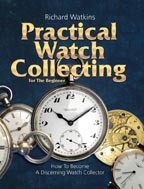5980 - Practical Watch Collecting for the Beginner
WATKINS RichardHow to Become a Discerning Watch Collector.
Review of Practical Watch Collecting for the Beginner Although there are thousands of books on mechanical watches (the author of this new book has listed 2,823 of these in detail in his previous book Mechanical Watches), surprisingly, there is no other book in print that starts at the very beginning, assuming the reader knows nothing about the history and technology of watches, and teaches in a logical and thorough manner what a budding collector should learn in the first few months of collecting watches. Richard Watkins is the ideal source for such instruction. He is foremost a teacher, not only by profession but also by mindset, and he is also one of the most systematic, meticulous, and thoughtful persons I know. In addition, he is one of the most thorough scholars of horological history I have ever met. Furthermore, he is an excellent and exceptionally clear writer, one of the very few who was awarded the Fellow designation by NAWCC for his horological writings rather than for service to the organization. After the introductory chapter (8 pages) the book is organized into five chapters: 1. The Looking Game (how to handle and open a watch, what to look for: 25 pages) 2. The Dating Game (providing a summary of watchmaking history in America, England, and Switzerland to help determine the approximate age of specific watches: 15 pages) 3. The Movement Game (a beginner’s introduction into watch technology, from basics to complications: 28 pages) 4. The Condition Game (assessing condition, fakes, cleaning, maintenance, and repairs: 26 pages) 5. The Collecting Game (a first introduction of subjects that go beyond the beginner-collector stage: 24 pages). Each chapter is copiously illustrated with detailed closeup photographs of watches from the author’s collection. Most photographs are inserted into the text pages to illustrate a specific idea in the text, and the majority have superimposed arrows or captions highlighting the point made. The author stresses practical advice. He begins with the commonsense advice for the novice to start with pocket watches, not only because the components are larger and more robust than in wristwatches but because the majority of pocket watches can be opened without specialized tools for examination. Throughout the book, every time a new horological term is introduced, it is defined in the text and shown in an accompanying illustration on the same page. The start is very basic, introducing terms such as case, dial, and movement, but as the author systematically goes through chapter 1 a great number of concepts and terms are introduced one after the other. Interspersed with watch technology and history is a great deal of practical interpersonal advice on how to interact with watch people, such as dealers, flea market sellers, auction houses, fellow collectors, etc., at different venues. Although the quality of the content matches that of books with generally higher prices, the publisher has worked hard to bring the retail price down; therefore, it is available only in a perfect-bound paperback edition. While all 329 illustrations are in full color, the choice was to use uncoated paper to control cost. This reviewer believes these are acceptable compromises; the assumption is that the reader will use the book hard—and often—during the first year of ownership, but that it is not an enduring reference text, because after some time the points covered will become obvious and second nature to most readers. The publisher intends to make the book available globally through a print-on-demand distributor, ensuring that it shows up globally on sites such as amazon.com and that it remains available once the initial print run is sold out. This reviewer also sees a possible second target audience: avid clock collectors, who have through their perusal of general (i.e., neither clock nor watch specific) texts on horological history accidentally picked up scattershot education about watches. For such readers Watkins’ book offers a chance to efficiently provide a basic introduction into both the technology and the marketplace for collectible watches. The book under review obviously fills a niche in the marketplace. It is most refreshing to finally see a collectors’ guide that does NOT focus on values and prices or on brand status but attempts to teach the beginning collector the basics of horology, through learning about the fundamentals of the technology and the history of portable timekeepers. I hope that the book will be sucessful because it deserves to become a classic in its subject category. That the author is a fanatical horological bibliophile, who constantly urges his readers to consult additional horological titles to round out their understanding of the subject matter, to this reviewer is just the icing on an already delectable cake. -Fortunat Mueller-Maerki
130 pages
Edition : 2012
Langue : anglais

